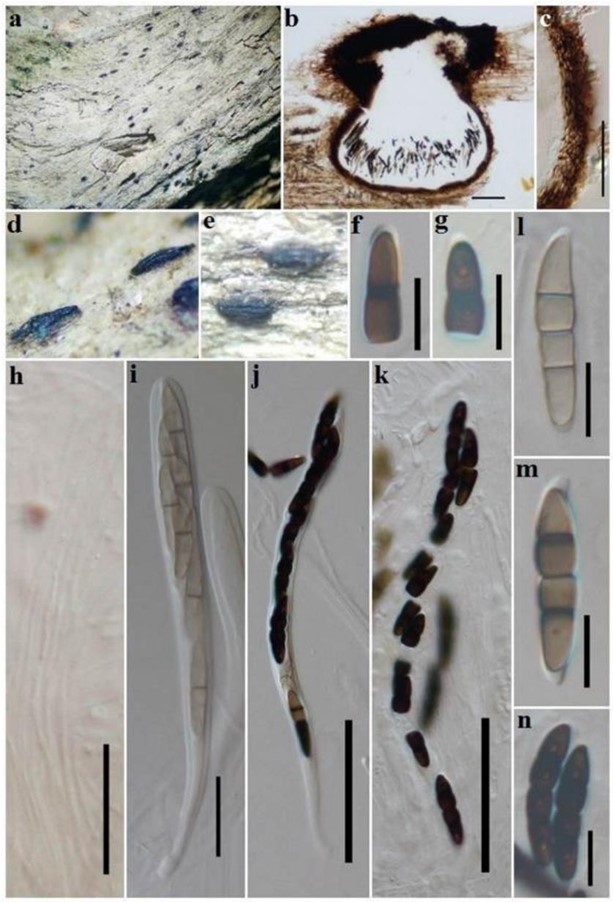Paralophiostoma hysterioides V.V. Sarma & M. Niranjan, sp. nov. Fig. 123
MycoBank number: MB 556724; Index Fungorum number: IF 556724; Facesoffungi number: FoF 06623.
Etymology – With reference to the erumpent hysterothecoid necks of the ascomata.
Saprobic on unidentified twigs. Sexual morph: Ascomata 565 high × 510 wide µm, immersed perithecoid ascomata with erumpent hysterothecoid to elongate slit-like necks, carbonaceous, scattered, clypeate, sub-globose, apically long slit-like ostioles, periphysate, Peridium 18–20 µm thick with several layers of textura angularis cells. Hamathecium comprising up to 1–1.8 µm width, filamentous, trabeculate pseudoparaphyses, hyaline, septate, unbranched, anastomosing, numerous. Asci (121)126–148(153) × 10–12.5 µm (x̅ = 133.8 × 11.4, n = 25), 8-spored, bitunicate, fissitunicate, broadly cylindrical, apically rounded with ocular chamber, long pedicellate. Ascospores 23.5–27.5 × 5.5–7 µm (x̅ = 26 × 6.2, n = 2 5), overlapping 1-seriate, fusiform, hyaline to pale brown when young, brown to dark brown at maturity, one septate with constriction when young, 3-septate with constrictions at maturity, central septum strongly constricted, tri-guttulate with each spore having one, supramedian cell, obtuse ends with thick apical caps and a thin (incipient) sheath, fully mature ascospores splitting into part spores. Asexual state: Undetermined.
Material examined – India, Andaman and Nicobar Islands, South Andaman, Chidiya Tapu, Viewpoint Area, (11˚28’10.3”N, 92˚41’08.3”E), on identified twig, on 9 December, 2017, M. Niranjan (PUFNI 17617), herbarium-AMH (AMH-9981) and Living culture (NFCC-4397 holotype) Additional specimens examined: Port Blair, Chidiya Tapu, Viewpoint Area (11˚28’46” N 92˚42’38”E) on unidentified twig (T334F1, T336F2) 20 May, 2018 Niranjan & Sarma.
GenBank numbers: LSU: MT912850, SSU: MT914175, ITS:MN582758, rpb-2: MT926117.
Notes – Paralophiostoma hysterioides has certain unique features such as long pedicellate asci and ascospores guttulate, with appendages and a thin incipient mucilaginous sheath, and fully mature ascospores splitting into part spores.

Figure 123 – Paralophiostoma hysterioides (PUFNI 17617, holotype). a Ascomata on host twig. b Ascoma. c Peridium. d, e Slit-like ostiole. f, g Part-spores. h Pseudoparaphyses. i–k Asci. l–n Ascospores. Scale bars: b = 100 µm, c, j, k = 50 µm, h, i = 20 µm, f, g, l–n = 10 µm.
